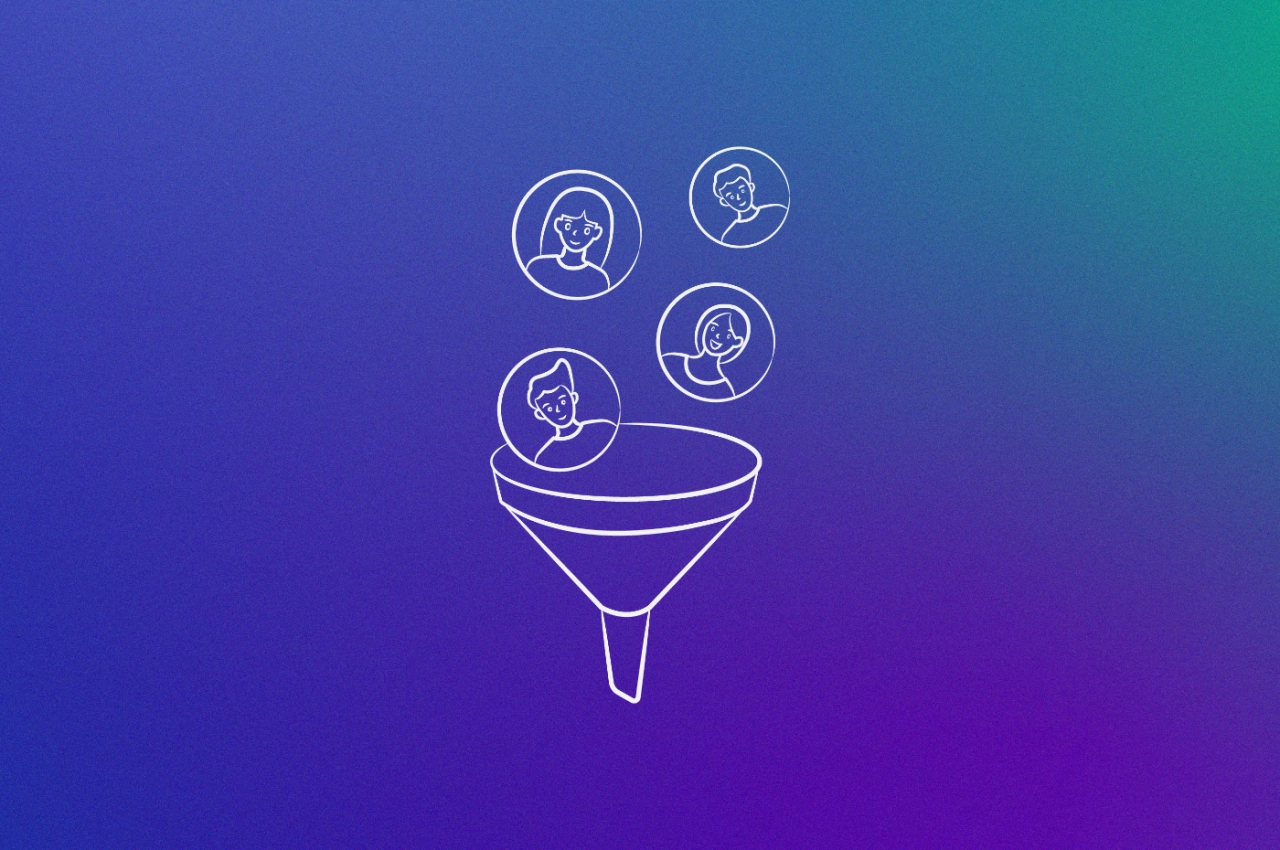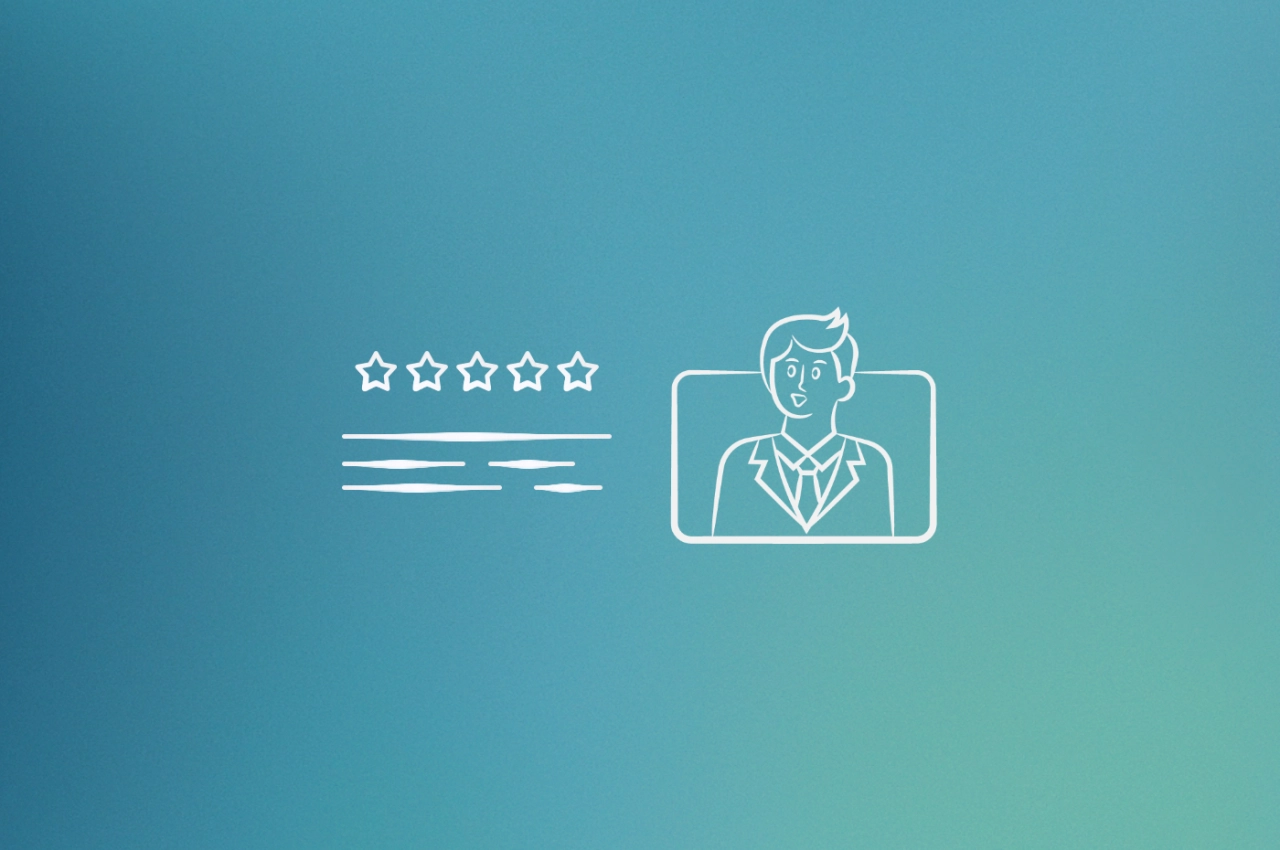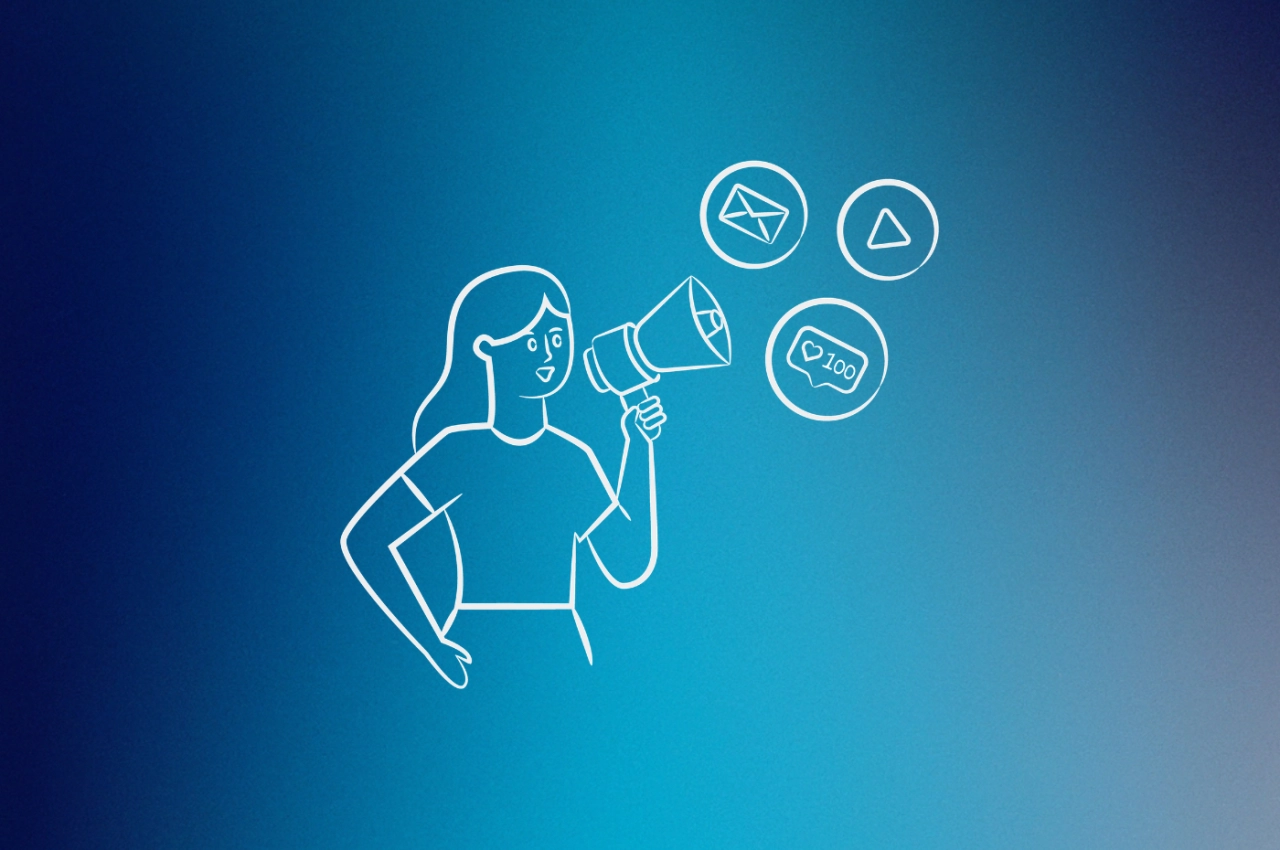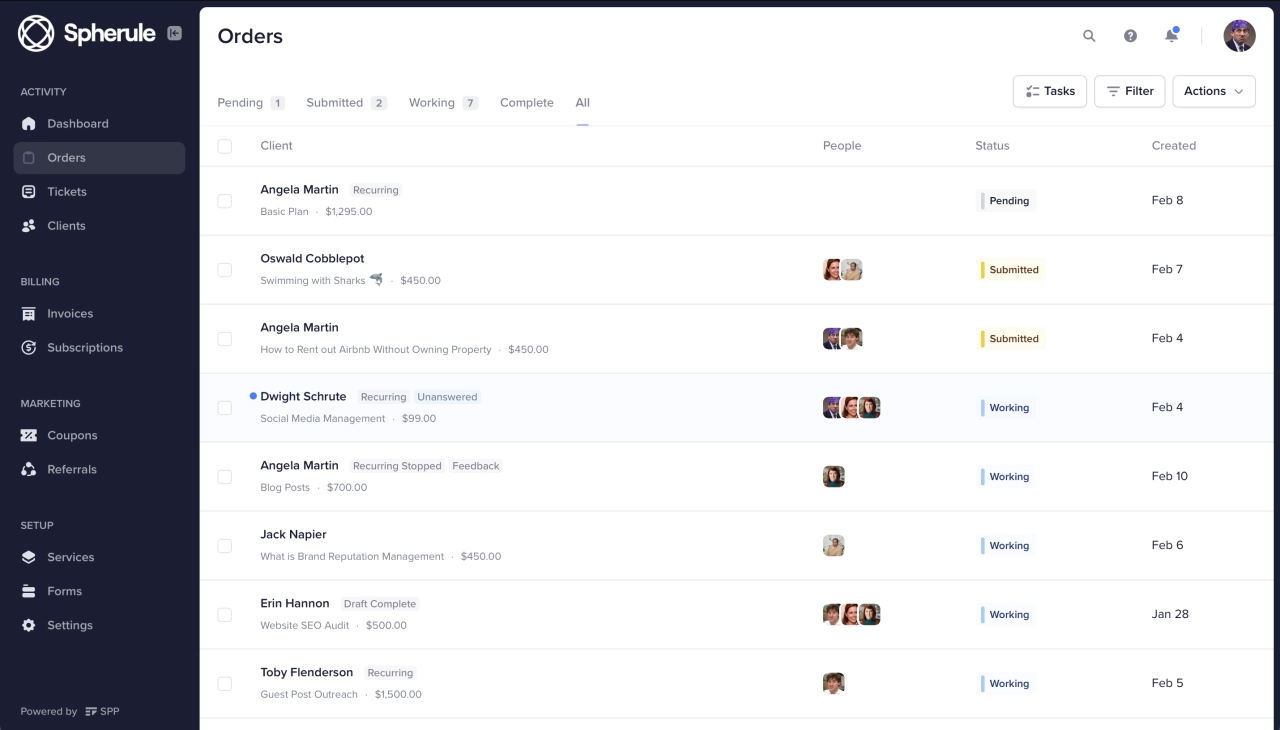- 54% of B2B marketers struggle most with improving lead quality and conversion (ViB Tech 2024). If you’re getting lots of leads but they’re not converting, you’re not alone. This guide shows you how to fix it.
- 69.6% of agencies say new business sales is their biggest challenge (SparkToro 2024). Most agencies try random tactics for a few weeks, get mediocre results, then jump to the next thing. You need a system you can stick with.
- Pick 2-3 strategies from this guide and commit for 6 months. The agencies that generate consistent leads don’t do everything. They pick what matches their budget and time, then go deep on those channels until they work.
You land a few clients through your network. Things are going well. Then growth stalls because you’ve already talked to everyone you know.
So you start scrambling. Networking events. Cold emails. LinkedIn posts. Hoping for referrals. Some months you get 2-3 leads. Other months, nothing. You can’t predict your pipeline, which means you can’t forecast revenue or plan hires.
The issue isn’t that lead generation is complicated. It’s that most agencies try everything for three weeks, see weak results, and jump to the next tactic. No strategy sticks around long enough to actually work.
Below are 13 strategies that work for agencies, with realistic timelines and what they actually cost. Pick 2-3 and stick with them for six months.
What is B2B lead generation?
B2B (Business to Business) lead generation is any process that involves identifying, attracting, and nurturing potential buyers for your agency. It works hand-in-hand with demand generation to create a sustainable pipeline of qualified prospects.
Sounds straightforward, right? It’s not. ViB Tech’s 2024 research found that more than half of B2B marketers (54%) struggle most with improving lead quality and conversion rates.
Lead generation has gone far beyond cold calling or emailing in the hope that prospects will become clients.

If you want to generate quality leads for your agency, you need a more structured approach. This includes:
Identifying and targeting the right prospects: Decision-makers who actually need your services
Helping potential clients solve problems: Give them value before they even become clients
Building and nurturing meaningful relationships: Stay top-of-mind through consistent, helpful connections
Giving clients great service after the sale: It’s cheaper to retain clients than to hunt for new ones
The goal of a B2B lead generation campaign isn’t to collect cold leads just to hit a number. You need to bring in qualified leads who will actually become paying clients. That’s how you get your money’s worth.
Why it matters for agencies
Every agency owner wants the same thing: to generate revenue for their company. You need a steady stream of ready-to-buy clients.
According to SparkToro’s 2024 State of Digital Agencies research, nearly 7 in 10 agencies (69.6%) say new business sales is their biggest challenge. Without a real lead generation process, agencies can’t scale.
The root cause often comes down to operational chaos. Evripides Gavriel, who has built automation frameworks that saved agencies over $11 million, identifies the core problem:
Most agencies actually struggle with their moneymaker—the operations that actually make them money, which is delivering to their clients. And the biggest factor in that is actually communicating with clients. They spend way too much time in communication because of a lack of transparency in their processes.
 Evripides Gavriel,
Evripides Gavriel,
When you’re drowning in client communication and delivery chaos, there’s no time or mental energy left for systematic lead generation.
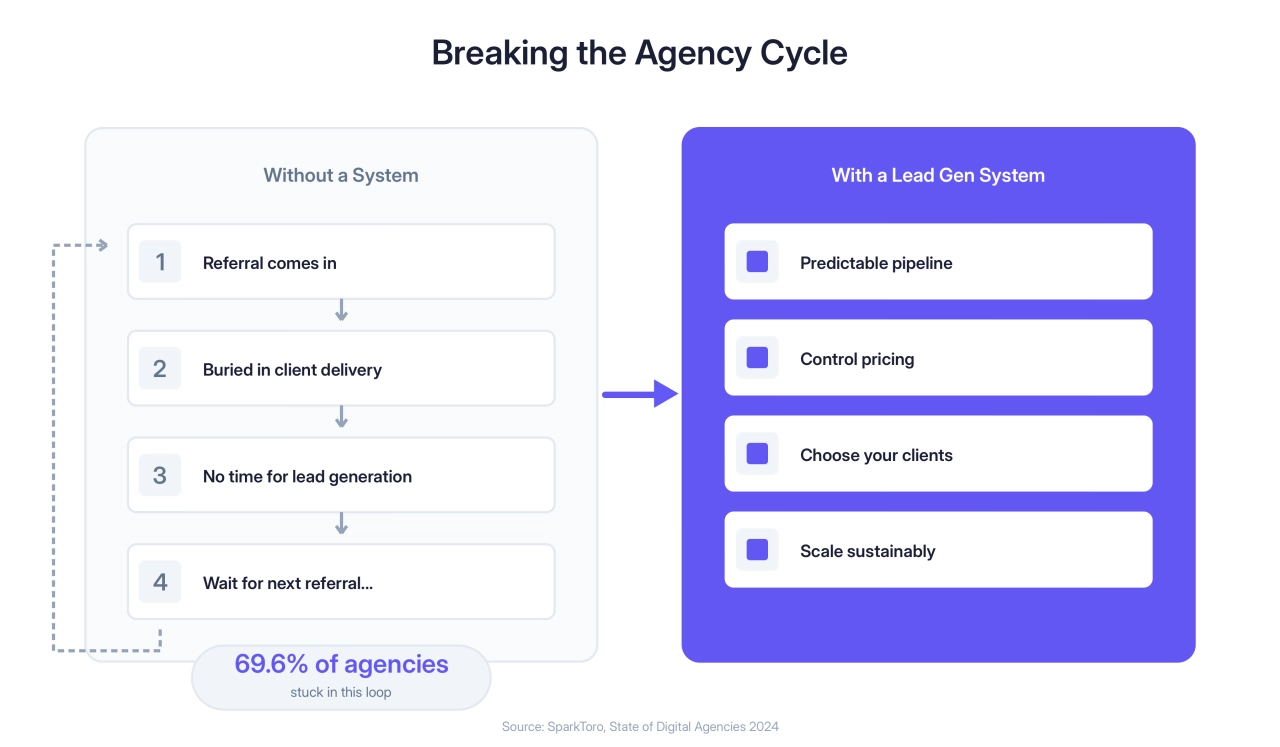
Most agencies lack a repeatable system. When you rely only on referrals and personal networks, you limit your growth and pricing power. With a healthy pipeline of qualified leads, you can be selective about clients and charge what you’re actually worth.
B2B lead generation builds a sustainable, profitable agency that doesn’t depend on luck or who you happen to know.
As Justas Malinauskas, CEO of Whatagraph, learned from running his own agency:
Customer relationships dragged us through recessions and downturns. Because if they really trust you, they will never look around the fence for another one. And they will never be tempted for a better offer, a cheaper offer. We were never the cheapest agency in place, but we were always maintaining our customers. I think I haven’t lost any customers in our agency.
 Justas Malinauskas,
Whatagraph
Justas Malinauskas,
Whatagraph
The combination of systematic lead generation plus strong client relationships creates an agency that can weather any economic storm.
How do you generate B2B leads?
Building those lasting relationships Justas describes starts with attracting the right leads in the first place. You’ve probably tried a few lead gen tactics and they’re not working as well as you hoped. Maybe you got a burst of leads from networking events, but it wasn’t sustainable. Or you tried cold email and got crickets.
I’ve been there.
What I know from building SPP.co and talking to hundreds of agencies: you don’t need to do everything at once. That’s actually the worst approach. The strategies below work individually, but they’re even more powerful when you combine a couple of them.
The key is picking one or two that actually match where you are right now. An agency with a $5,000 monthly marketing budget is in a completely different place than one with $50,000. And that’s totally fine. Work with what you’ve got.
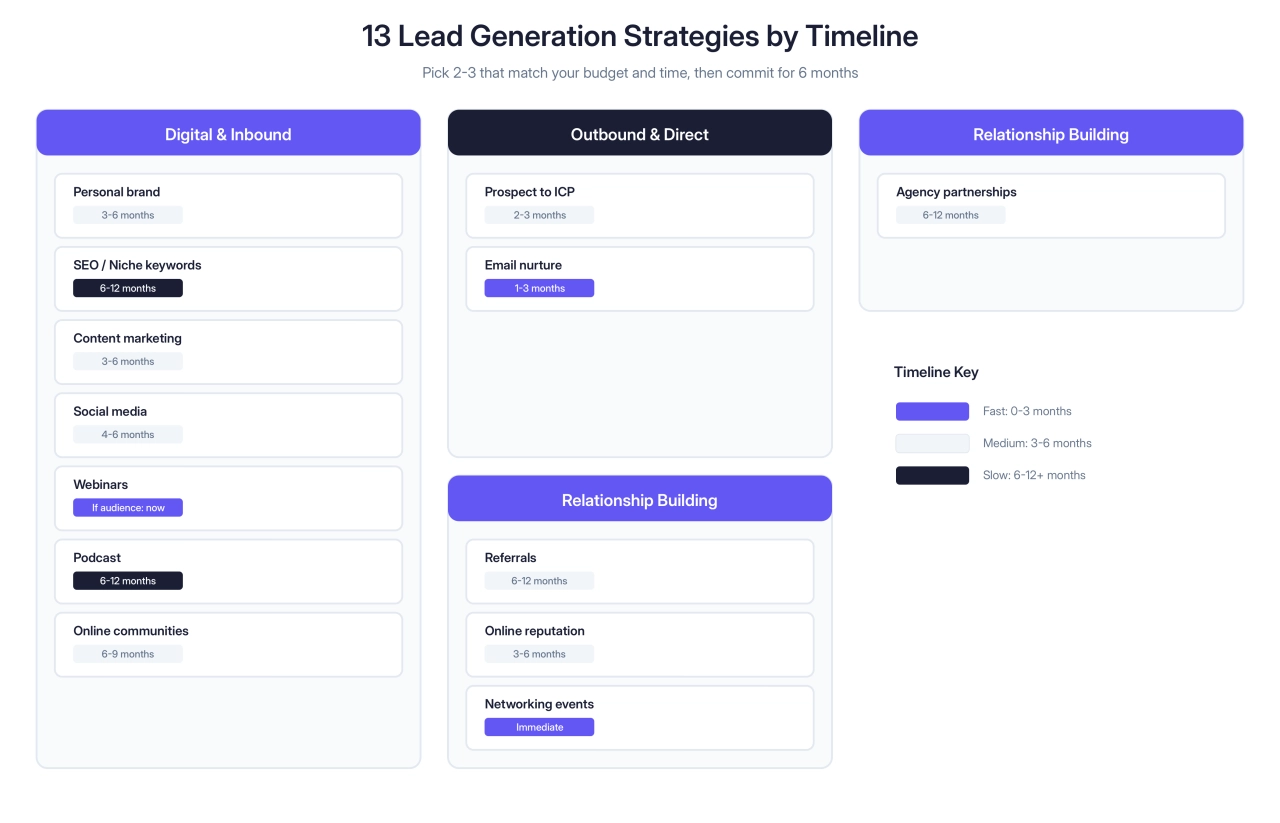
Let me walk you through thirteen proven strategies that agencies use to generate qualified B2B leads consistently.
Digital & inbound strategies
These strategies bring leads to you instead of you chasing them.
Build a personal brand to attract inbound leads
This one makes most agency owners uncomfortable. I get it. Putting yourself out there feels weird when you’re used to letting your work speak for itself.
But here’s what actually happens when you build a personal brand: potential clients start finding you. They’ve already decided you know your stuff before you ever get on a sales call. The entire sales dynamic changes.
LinkedIn’s research backs this up: sales pros with strong personal brands generate 45% more opportunities and hit quota 51% more often.

Why this works in B2B: buyers want to work with people they trust. When you’re consistently sharing insights that actually help people (not just 5 tips posts that say nothing), you build that trust way before any money conversation happens. By the time they’re ready to buy, you’re the obvious choice.
Take Joe Davies from FatJoe. He built his SEO marketplace from zero to $12.6 million largely through personal branding. Joe shares content on Twitter and LinkedIn about SEO, agency life, entrepreneurship - but here’s the smart move: he created free tools like FatRank (a Chrome extension with 60,000 users now) to build authority and capture leads at the same time. His personal brand attracts agency clients because he’s authentic, helpful, and shows up consistently sharing what actually works.
What you actually need to do:
Pick your lane: “Marketing agency owner” is too broad. “B2B SaaS demand generation for Series A startups” gives you a clear space to own. If you need ideas, check out our guide on lead generation niches.
Go deep on one platform: You don’t need to be everywhere. Pick where your ideal clients actually spend time. For most B2B agencies, that’s LinkedIn, though it varies by niche.
Share stuff that actually helps: Write about challenges you’ve solved, frameworks you’ve built, mistakes you made and what you learned. The format depends on your audience and what feels natural to you - posts, articles, videos, podcasts, whatever.
Show up consistently: Here’s the hard truth: you need 3-6 months of posting 3-5 times per week minimum before you see meaningful lead flow. Block time on your calendar and protect it like client delivery work.
Actually engage with people: Comment on posts, answer questions, join conversations. You’ll build real relationships and learn what potential clients are struggling with. That intel makes your content better.
Personal branding requires 3-6 months before you see meaningful lead flow. According to LinkedIn’s data on Sales Social Index, consistent posting and engagement for 6 months correlates with 45% more opportunities. Agencies that maintain this discipline typically generate 5-10 qualified inbound leads per month by their first year.
Rank for niche keywords that bring ready-to-buy clients
Most agency owners know SEO brings in high-intent traffic. Understanding SEO matters isn’t your main problem, but figuring out which keywords to target when you’re competing against established players with bigger budgets and 10-year head starts.
Here’s what works: stop going after broad terms. You’ll never rank for “digital marketing agency” or “SEO services” unless you’re willing to invest years and serious money competing against Wpromote and Siege Media.

Go specific instead. Target bottom-of-funnel keywords where competition is thinner and search intent is higher.
Focus on buyer-intent keywords with lower competition: These are searches people make when they’re actively looking to hire someone right now. “[your service] for [specific industry]” or “[problem] solution for [company size].”
Example: if you’re a paid ads agency focusing on SaaS, target “PPC management for B2B SaaS” or “Google Ads agency for enterprise software” instead of just “PPC agency.”
You can rank for these specific phrases within 3-4 months because there are maybe 5 competitors instead of 500. And the people searching these terms are way more likely to convert - they know exactly what they need.
Create content around problems your clients actually bring up: Look at the questions prospects ask during sales calls. Those questions are what they’re Googling before they ever talk to you.
If clients constantly ask “How do I calculate CAC for my agency?” - write the comprehensive guide on that. If they struggle with “How to structure retainer pricing for marketing services” - create the definitive resource.
This builds topical authority. Google sees you consistently answering related questions in your niche, and your rankings improve across the board.
One thing agencies miss: SEO isn’t just about ranking. You also need copy that actually converts visitors into leads. Make sure you understand lead generation copywriting or you’ll get traffic that goes nowhere.
Setting realistic expectations: SEO is a 6–12 month investment. You’ll start seeing traffic around month 3–4, but meaningful lead generation usually kicks in around month 6. Budget $2,000–$5,000 per month for a solid program (or invest that in internal resources if you’re doing it yourself).
For agencies, SEO is one of the most important lead generation channels you can focus on - but only if you pair it with content that converts.
Create content that drives lead generation
Content does a bunch of things at once. It increases awareness, supports your SEO, and positions your agency as the expert. But here’s the thing: your content has to be genuinely helpful. Generic advice doesn’t move the needle.
The ROI makes it worth it, though. Content Marketing Institute’s 2024 research shows 58% of B2B marketers report an increase in sales and revenue thanks to content marketing.
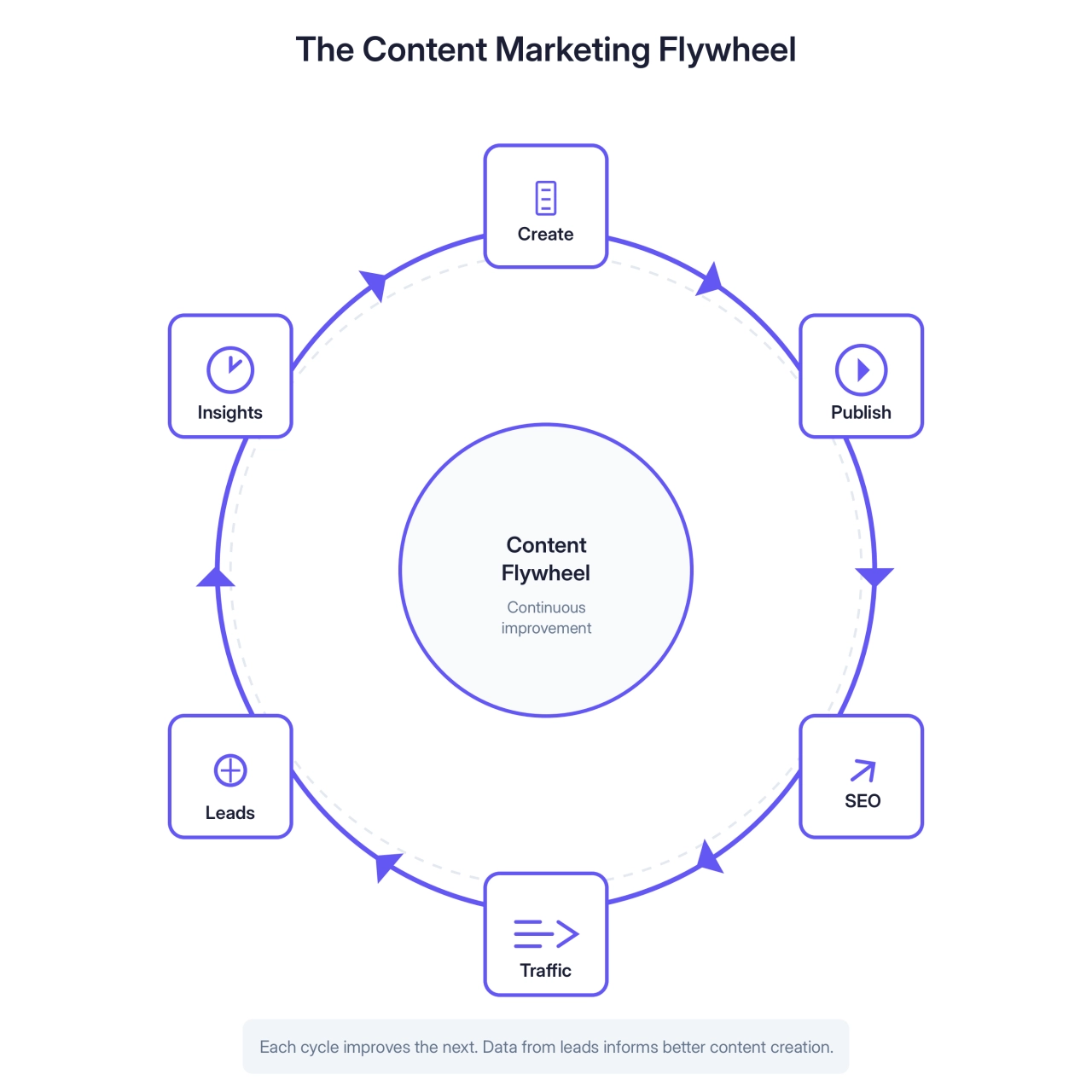
What actually works for agencies:
Long-form guides (2,000+ words) that thoroughly answer the questions your prospects are asking
Case studies showing specific results you got for clients
Industry insights and analysis of what’s changing in your space
How-to tutorials that showcase your expertise without giving away the farm
Let me be honest about timelines: Building a content library isn’t easy. You’re probably looking at creating about 100 blog post or more to cover all relevant topics. You’ll start seeing lead impact after you have the majority of these pieces published, and your authority is established.
If you want more tactical guidance, I wrote a step-by-step tutorial on using content marketing to generate leads.
Important connection: Content marketing powers your SEO (strategy #2), gives you material for building your personal brand (strategy #1), and provides stuff to share on social media (strategy #4). See how these all tie together?
Use social media to reach decision-makers
Your prospects are on social media. Like, a lot. HubSpot’s 2025 State of Marketing report shows social media continues to be a top channel for marketers, with short-form video delivering the highest ROI.
For B2B agencies, LinkedIn is your best starting point with over 1 billion business professionals. But don’t write off Twitter, Instagram, or even TikTok, because your ideal clients use these platforms too.
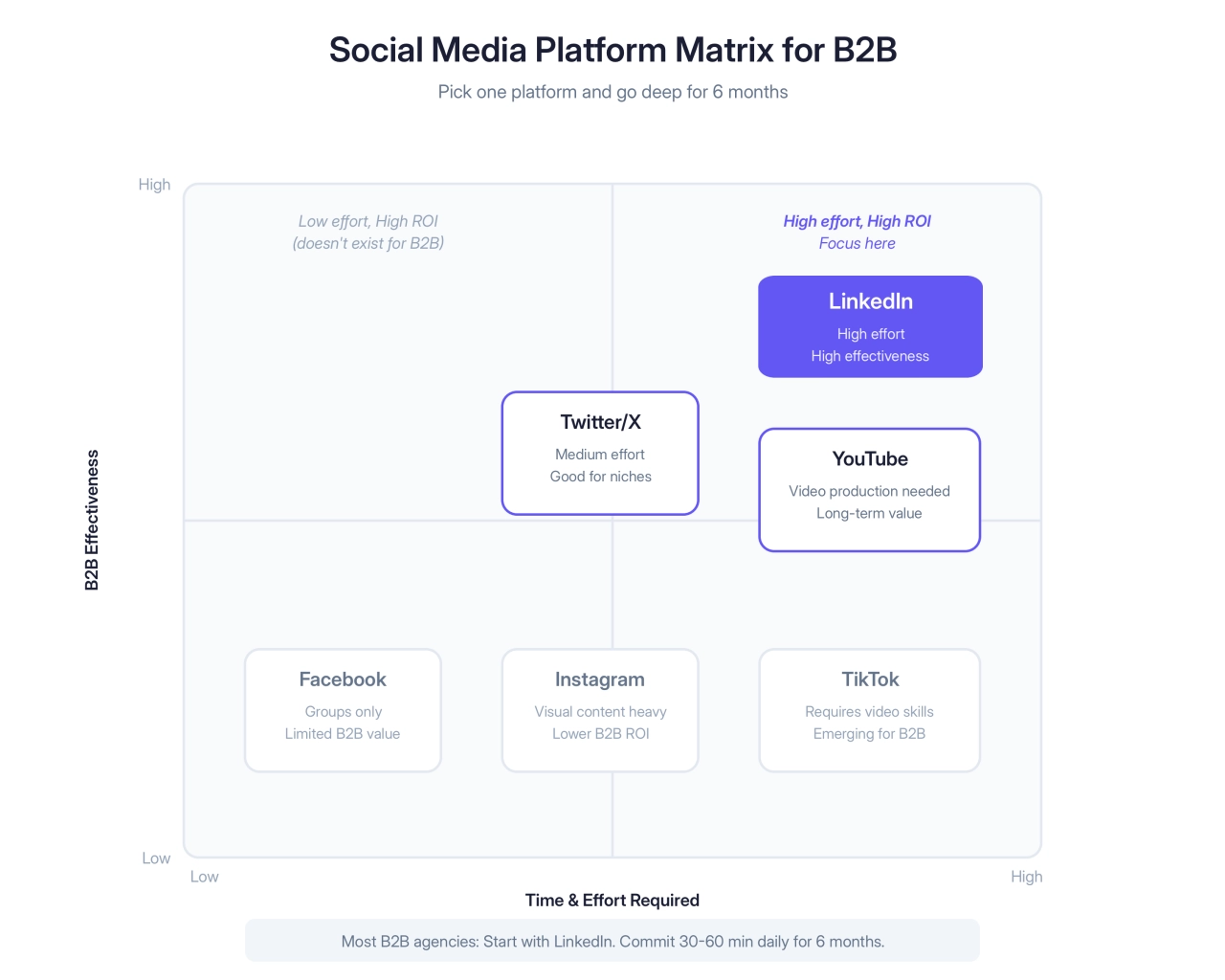
Focus on 2–3 platforms maximum and commit 30–60 minutes daily to posting, engaging, and building relationships. You’ll start seeing consistent lead flow after 4–6 months of regular activity.
For detailed social media strategies including LinkedIn Sales Navigator, Twitter social listening, and platform-specific tactics, see our comprehensive guide on how to find B2B clients.
The connection: Social media amplifies your personal brand (strategy #1) and distributes your content (strategy #3). They work way better together than in isolation.
Host webinars to capture qualified leads
Webinars work, but the conversion math only matters if people actually register. Here’s the funnel with real numbers:
Audience Size | Expected Registrations | Actual Attendees | Leads Generated |
|---|---|---|---|
500 LinkedIn connections | 10–15 (2–3%) | 5–7 show up | 0–1 qualified lead |
2,000+ email list | 40–80 (2–4%) | 20–40 show up | 2–4 qualified leads |
5,000+ engaged audience | 150–250 (3–5%) | 75–125 show up | 8–12 qualified leads |
The funnel: Promote your webinar on LinkedIn, Twitter, and relevant Facebook groups. Send people to a lead gen landing page where they enter their email to register. After the webinar, nurture attendees with email campaigns until they’re ready to have a real conversation.
The registration problem everyone ignores: “Promote on LinkedIn” doesn’t work unless you have an audience. If you have 300 connections and no email list, your webinar gets 5 registrations. Not worth the 10–15 hours of work.
When webinars actually make sense:
you have 1,000+ email subscribers or engaged LinkedIn connections
you’re willing to spend $300–500 on LinkedIn/Facebook ads to drive registrations
you can get a co-host with their own audience (doubles your reach)
you’re inviting existing prospects and using the webinar to move them forward (not cold audience building)
The math: Hosting costs $100–200/month. Add 10–15 hours of your time ($1,500–2,250 at $150/hour). Each webinar costs $1,700–2,500 all-in. If you get 2–4 qualified leads, you need a 25-50% close rate on $5k+ deals just to break even.
Smarter alternative for small audiences: Instead of public webinars, do personalized demos. Invite 5-10 qualified prospects to a private workshop on a specific topic. Better attendance, more control, same educational format.
Industry averages: 30–40% of landing page visitors register, 40–50% of registrants attend, 5–10% become clients within 90 days. Your results will be worse in year one when you’re building credibility.
Timeline: Assuming you have the audience, first webinar can generate leads immediately. Building webinars into a reliable channel takes 4–6 monthly events to dial in your format and follow-up.
Skip if: You’re under 1,000 engaged audience members and not willing to pay for ads. Focus on building your audience through content and personal branding first.
Host a podcast to build authority
Podcasts work for B2B lead generation, but most agency owners underestimate the commitment. Here’s what it actually takes:
What You Need | Reality Check |
|---|---|
Time commitment | 8–12 hours/month (recording, editing, promotion) |
Startup cost | $200-500 (mic, interface, software) |
Monthly cost | $15-40 hosting + $100-300/episode if outsourcing editing |
First guests | Your network, existing clients, peers (not industry titans) |
Timeline to leads | 6-12 months for audience growth; immediate if using as prospecting tool |
Best for | Enterprise deals ($50k+), relationship-based sales, not maxed on billable hours |
Skip if | Under $200k ARR needing fast results, already at 35+ billable hours/week |
The smart play: Invite 2–3 ideal prospects per month as guests. The conversation becomes your sales process. Even with 50 downloads per episode, you’ve had a 45-minute relationship-building call with a qualified buyer.
Podcasting is high effort with slow ROI from audience building, but immediate potential from guest relationships. If you’re patient and selling high-ticket services, it works. If you need faster results, focus on personal branding or SEO instead.
Engage in online communities
Online communities give you direct access to people asking questions you can answer. Nicolas Cole grew Digital Press to seven figures partly by answering questions on Quora, but success requires consistency:
Commitment Level | Time Investment | What You Get |
|---|---|---|
Serious | 30–45 min/day (3+ hours/week) | Consistent visibility, 3–6 months to regular leads |
Realistic | 15 min 3x/week (45 min/week) | Slower build, 6–9 months to occasional leads |
Testing | 20 min 1x/week | See if your niche is active before committing more |
Start with testing: Pick one community where your ideal clients hang out (r/marketing, specific LinkedIn groups, niche Slack communities). Spend 20 minutes weekly for a month. If you’re getting engagement, scale up. If crickets, move on.
Answer questions thoroughly in your comment, then link to your content only if it adds genuine value. Skip the “Great question! Check out my blog…” approach.
Skip if: You’re already maxed on billable hours and doing personal branding on LinkedIn. Communities are redundant, so focus on one channel well.
Outbound & direct strategies
If you don’t want to put all your lead gen into the inbound basket, you can also be more proactive.
Prospect only to your ideal customer profile
When it comes to prospecting for ideal clients, a common approach business owners take is to buy an email list, blast unsolicited emails to thousands of people, and wait for responses.
When they hear crickets, they say outbound prospecting is dead.
But let’s face it. Nobody wants to read an email from someone they don’t know or have never heard of, let alone do business with them.
Does this mean outbound lead generation is a bad strategy? Absolutely not.
Reaching out to your ideal clients rather than waiting for them to come to you is a proactive approach that can help you find new customers faster. In fact, this approach can be one of the best tools in your go-to marketing strategy toolkit, but it only works if you do it right.
How do you do it right?
For starters, ensure you’re targeting only your ideal customers. This way, you can craft tailor-made emails or social media messages that address their needs and pain points. Doing this will increase your chances of getting positive responses from prospective clients.
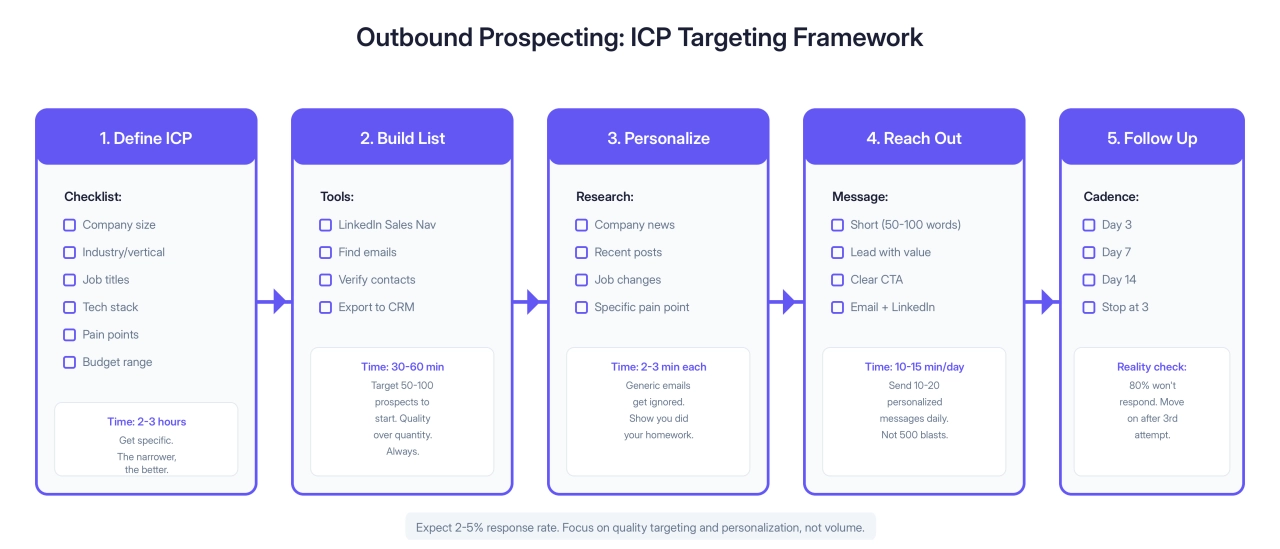
Build a targeted list based on specific criteria: company size, industry, job title, technology stack, and recent company activity. Use tools like LinkedIn Sales Navigator to identify decision-makers who match your ICP. Then create personalized outreach that speaks directly to their challenges and shows you’ve done your homework.
Timeline: Outbound can generate responses within days, but building a sustainable outbound engine takes 2-3 months of testing and refinement to find what messaging resonates with your ICP.
Nurture leads via email marketing
B2B buyers don’t become clients overnight. They move through a lead generation funnel where they go from cold leads to warm leads and finally hot leads before making a purchase. According to Gartner’s 2023 B2B Buying Journey research, the typical B2B purchase involves 6 to 10 decision-makers and spans 3 to 6 months for mid-market deals.
Email marketing helps you stay connected during that journey. Send helpful content - case studies, webinar invites, industry insights - that builds trust and keeps you top of mind until they’re ready to buy.
How to build your email list:
Offer something valuable in exchange for contact information. A lead magnet.
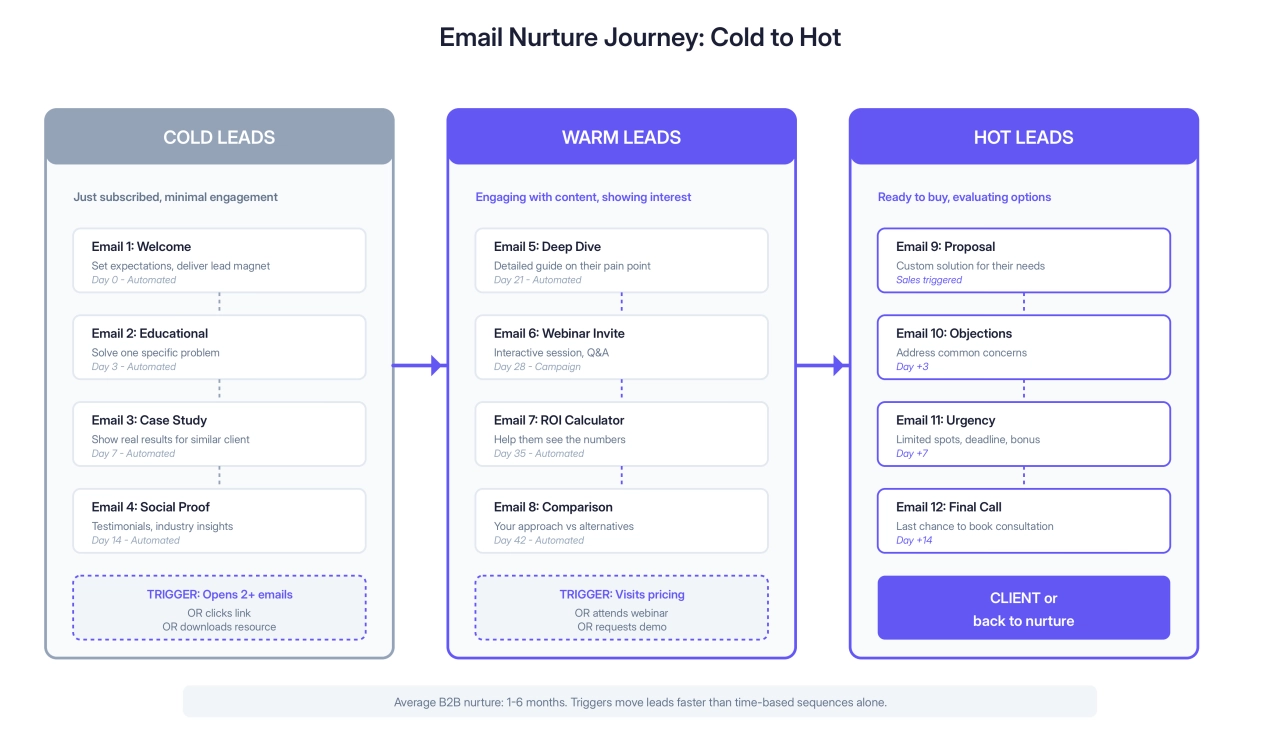
Examples: ebooks, industry reports, whitepapers, free trials, webinar access, product demos, exclusive event invites. Share your lead magnet on relevant platforms and consider paid ads to reach more people.
Whatever you offer, make sure it’s relevant to your audience and reflects your expertise.
Take SPP for example. In exchange for an email address, subscribers receive our e-book on productization - helping agencies package their services more effectively.
Timeline: Email nurture sequences can be set up in a week, but seeing ROI typically takes 1-3 months as leads move through your funnel. The key is consistency and providing genuine value at every touchpoint.
Leverage word-of-mouth and referrals
Think about the last time you purchased a product. Chances are you did so based on a friend or colleague’s recommendation. That’s the power of word-of-mouth marketing.
When your existing clients are happy with the service you’ve provided, they’re often willing to provide testimonials and refer you to their peers. Research from the Wharton School of Business shows that referred customers have a 16% higher lifetime value and 37% higher retention rates than customers acquired through other channels.
Referrals from other businesses convert well because most B2B buyers value the opinions of their friends or business partners when making a buying decision.
Make referrals systematic: Don’t wait for referrals to happen organically. Create a formal referral program that rewards clients for sending business your way. This could be a discount on future services, a finder’s fee, or access to exclusive resources.
Ask at the right time: The best moment to request a referral is right after delivering exceptional results. When a client is thrilled with your work, strike while the iron is hot: “I’m so glad we achieved [specific result] for you. Do you know any other [business type] who might benefit from similar results?”
Timeline: Referrals can happen immediately after delivering great work, but building a referral engine takes 6-12 months of consistently delighting clients and implementing a systematic ask process.
Relationship building strategies
These strategies leverage trust, credibility, and networks to bring you clients through reputation and referrals.
Maintain a positive online reputation
92% of B2B buyers are more likely to purchase after reading a trusted review, according to G2’s The Impact of Reviews on B2B Buyers and Seller. Your reputation on Clutch, G2, Trustpilot, and Google Business directly impacts whether prospects reach out.
The time investment: Budget 2–3 hours per month across 4 or 5 platforms (requesting reviews, responding, quarterly audits).
Getting your first 10 reviews: Budget 3 to 6 months for this milestone. Based on G2’s data on review collection, the average response rate for review requests is 15–20%. You’ll need to ask 50 to 70 clients to receive 10 completed reviews. Non-responses and abandoned requests are normal friction in the process.
Who to ask:
clients who just got great results (strike while they’re thrilled)
long-term clients who trust you (18+ months)
clients who’ve already given testimonials (proven advocates)
Make it stupid easy: Send the direct review link with 2–3 bullet points about what to mention (results delivered, your process, why they’d recommend you). Most people want to help but don’t know what to write.
Response timing: Thank positive reviews within 48 hours. For negative reviews, respond professionally within 24 hours acknowledging their concern and offering to resolve privately. Never get defensive publicly because prospects are watching.
Timeline: First 5 reviews take 2 to 3 months if you’re actively requesting. Building to 20+ takes 6–12 months. According to BrightLocal’s review survey research, businesses with 1–5 reviews see a 270% higher likelihood of being chosen by customers compared to those with zero reviews.
Skip if: You’re under 10 total clients. Focus on delivery excellence first, then build your review profile once you have a base of happy clients to request from.
Participate in networking events
Conference ROI is simple math: if you spend $5,000 (ticket + travel + 2 days not billing), you need to close one $15k+ client within 6 months to break even. Here’s how to pick the right events:
Agency Type | Target Events | Typical Cost | What to Expect |
|---|---|---|---|
Performance marketing | Traffic & Conversion Summit, MozCon | $1,500–2,000 + travel | 20–30 qualified conversations, 3–5 serious follow-ups |
Web design/dev | An Event Apart, Webflow Conf | $1,000–1,500 + travel | Portfolio reviews, 5-10 potential leads |
B2B/SaaS agencies | SaaStr, B2B Marketing Exchange | $2,000–3,000 + travel | High-ticket prospects, longer sales cycles |
Local networking | Chamber of Commerce, BNI | $500–800/year | Referral network, local clients only |
Follow-up math: From a conference, expect to have 20–30 conversations. Of those, 5–10 will ask to connect. Follow up within 48 hours with personalized LinkedIn message. If no response after second follow-up (7 days later), they’re not interested. Don’t chase beyond 2 touches.
When events actually work: If you’re selling $25k+ retainers, one conference client pays for 5 events. If you’re selling $5k projects, you need 3–4 closes per event to justify the cost. Do the math for your deal size before buying a ticket.
Skip if: You’re under $100k ARR and burning cash, your average deal is under $10k, or you hate small talk (seriously, if networking drains you, it shows).
Timeline: First event might generate a lead immediately. Building a reputation where people seek you out at events takes 2–3 years of consistent attendance.
Form partnerships with other agencies
Most agency owners see other agencies as competition. But if you’re an SEO agency getting social media leads you can’t serve, that’s money walking out the door. Agency partnerships turn those into revenue.
Referral fee structure:
Deal Structure | Referral Fee | When It Works |
|---|---|---|
One-time projects | 10–15% of project value | Simple handoff, you’re not involved after intro |
Retainer clients | 10% of first 3–6 months | Ongoing work, partner handles relationship |
Revenue share | 5–10% ongoing | When you maintain client relationship, partner delivers service |
Put it in writing: Simple one-page agreement covering fee structure, payment terms (Net 30), non-circumvention clause (12-month period), and exit terms. Yes, partners can steal your referrals, which is why you start with small projects ($5–10k) to test trust before sending $50k deals.
Finding good partners: Look for agencies at similar revenue levels. Bigger agencies won’t prioritize your referrals. Smaller ones might not deliver quality that protects your reputation.
Reality check: Partnership referrals typically happen once or twice per year per partner, not monthly. This matches data from the Agency Management Institute showing that successful agency partnerships generate 3 to 5 qualified referrals annually per active relationship.
Building strong agency partnerships requires treating them like client relationships. Kris Flank from LunarLinks, who works with both agencies and direct brands, emphasizes the human element:
At the end of the day, you won’t buy a link from a random person on LinkedIn that just messaged you. You buy it from someone that you know. You need to just be human. I think that’s quite important, especially in the entire world of AI at the moment because you see all the same messages on LinkedIn.
 Kris Flank,
LunarLinks
Kris Flank,
LunarLinks
The same principle applies to referral partnerships. Generic “let’s partner up” LinkedIn messages get ignored. Actual relationships, which are built through regular check-ins, shared wins, and genuine collaboration, generate consistent referrals.
Timeline: First referral can happen within weeks if you both have immediate opportunities. Building a partnership that consistently generates 3–5 leads per year takes 6–12 months of proving you both actually refer quality opportunities.
Which tools can help with B2B lead generation?
You’ve just read through 13 strategies. The natural question: how do you actually execute this without drowning in manual work?
The answer is strategic automation. The right tools turn a 20-hour weekly prospecting process into 2 hours of focused effort. They’re the difference between 5 leads per month and 50.
The mistake I see agencies make: buying every tool that promises results, barely using any of them, then wondering why lead generation still feels like chaos.

I’m not going to walk you through all tools on the market but the above graphic shows you what can move the needle. If you want to have a look at more tools, you can check out our list with the best lead generation software.
My take on what to buy first
If you’re just starting out with limited budget: LinkedIn Sales Navigator + SPP.co. Sales Navigator helps you find leads, SPP.co makes it easy for them to buy. That’s the core loop.
Sales Navigator isn’t your only option for prospecting data. If the pricing doesn’t fit or you need better coverage in your industry, compare ZoomInfo or alternatives—database quality varies a lot by vertical and company size.
Once you’re consistently hitting 20+ leads per month, add Findymail to scale your outreach and Intercom to catch website visitors who are ready to talk.
OptinMonster only makes sense when you have real website traffic (500+ monthly visitors). Before that threshold, your time is better spent creating content that actually drives traffic in the first place.
The biggest mistake agencies make? Buying every tool at once, barely using any of them, and wondering why results don’t improve. Pick two tools, use them obsessively for 90 days, then add more as needed.
How to measure B2B lead generation success
Once you’ve got your tools in place, the next question becomes: how do you know if any of this is actually working? That’s where measurement comes in.
Most agency owners can’t tell me which lead gen channels actually make them money. They know LinkedIn “feels like it’s working” or SEO “brings in some traffic,” but they have no idea if they’re getting a return on the time and money they’re investing.
That’s a problem when you’re trying to scale. You can’t double down on what’s working if you don’t know what’s working. You can’t cut what’s wasting money if you’re not tracking costs.
Here’s what you actually need to measure.
Essential B2B lead generation metrics to track
Let's take a look at 4 metrics you should keep an eye on:
Lead-to-customer conversion rate: How many of your leads actually become paying clients? If you generated 100 leads and closed 5 clients, that’s a 5% conversion rate. This tells you if you’re attracting the right people or just collecting contact info.
Lead generation cost (cost per lead): Take your total lead gen spend for the month and divide it by the number of leads you generated. If you spent $5,000 and got 50 leads, your cost per lead is $100. Simple math, but most agencies don’t track this consistently.
Customer acquisition cost (CAC): This is bigger than just lead gen. Add up all your sales and marketing costs (including salaries, tools, ads, everything) and divide by the number of new clients you closed. If you spent $20,000 total and got 5 clients, your CAC is $4,000.
LTV to CAC ratio: Divide your LTV by your CAC. If your LTV is $90,000 and CAC is $4,000, your ratio is 22.5:1. Anything above 3:1 is generally healthy. Below that and you’re spending too much to acquire customers.
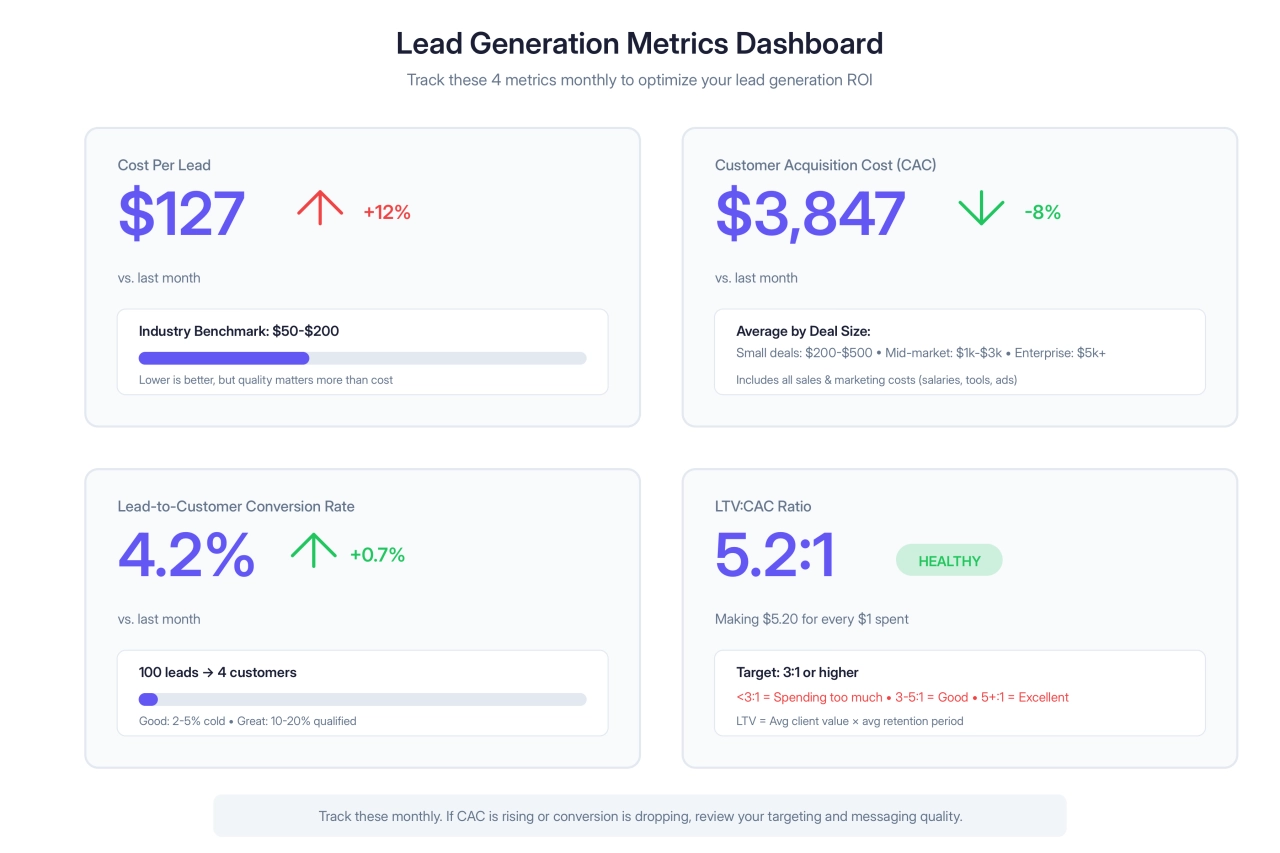
Also track these two:
Time to close: How long does it take from first contact to signed contract? This helps you forecast revenue and understand which channels bring in faster-closing deals.
Customer lifetime value (LTV): How much revenue does an average client generate over their entire relationship with you? If clients pay you $5,000/month and stay for 18 months on average, your LTV is $90,000. This number tells you how much you can afford to spend acquiring customers.
Industry benchmarks for B2B lead generation
Good performance across B2B agencies looks like this, based on research from HubSpot, FirstPageSage, and Ruler Analytics:
Metric | Good Performance | What It Means |
|---|---|---|
Cost per lead | $50–$200 | Lower is better, but quality matters more than cost |
CAC | $200–$500 (small deals) to $5,000+ (enterprise) | Varies hugely by deal size and sales cycle |
Lead-to-customer rate | 2–5% (cold leads) / 10–20% (qualified leads) | Higher means better targeting and qualification |
LTV:CAC ratio | 3:1 or higher | You want to make at least $3 for every $1 spent acquiring |
Time to close | 1–6 months for B2B | Longer for enterprise, shorter for SMB deals |
Don’t obsess over hitting these exact numbers. Your industry, deal size, and target market all affect what’s normal for you. Track your own baseline and improve it over time.
How to calculate ROI on lead generation
The formula: (Revenue from leads - Cost of lead generation) / Cost of lead generation × 100
Let’s say you spent $10,000 on lead gen last quarter. Those leads eventually converted into $60,000 in revenue. Your ROI calculation looks like this:
($60,000 - $10,000) / $10,000 × 100 = 500% ROI
That’s a solid return. But here’s the catch: you need to track which leads came from which channels and how much revenue they actually generated. Most agencies don’t have this dialed in, which is why they can’t tell you what’s working.
Setting up your CRM and tracking system
You don’t need fancy dashboards or expensive analytics tools when you’re starting out. You need consistency and discipline.
Use a CRM (yes, really): Every lead goes in the CRM with a source tag (LinkedIn, referral, SEO, cold email, whatever). No exceptions. When they become a client, you can trace back to where they came from.
Tag your marketing channels: Use UTM parameters on all your links so you know which blog post or ad drove traffic. Google Analytics is free and does this fine.
Track monthly, review quarterly: Update your metrics spreadsheet monthly. Cost per lead this month vs last month. Conversion rates. Which channels performed. But only make big strategic decisions quarterly, once you have enough data to spot real trends.
Connect revenue to sources: This is the hard part most agencies skip. When someone becomes a client, mark which lead gen channel brought them in. After six months, you’ll see patterns. Maybe your LinkedIn content generates fewer leads but they close faster and spend more. That’s valuable information.
The goal isn’t perfection. It’s knowing enough to make smarter decisions about where to invest your time and money.
Once you’re tracking these metrics, the next step is prioritizing which leads deserve immediate attention. Lead scoring helps you rank prospects based on fit and engagement. For a complete framework on implementing lead scoring, see our guide on MQLs vs SQLs.
Overcoming common B2B lead generation challenges
Let’s talk about the stuff that actually slows agencies down. These are issues that come up again and again when you’re trying to scale lead generation.
Sales and marketing alignment
Sales and marketing misalignment consistently ranks as a top obstacle to growth. HubSpot’s State of Marketing report shows that only 30% of sales and marketing teams describe their alignment as strong, while 70% acknowledge communication gaps affect lead quality and conversion rates.
This disconnect happens because marketing and sales are measured on different metrics and lack structured communication about what’s working.
The root cause often comes down to operational chaos. Freia Muehlenbein, owner of Be Right Agency Advisory, explains what she sees when agencies struggle with growth:
Senior leaders often look at the numbers and think, ’why is everyone complaining when on paper everything should be fine? We don’t need to recruit because on paper we have the right headcount.’ But the delivery teams are screaming for more capacity. There’s a disconnect between numbers versus what’s actually happening.
 Freia Muehlenbein,
Be Right Agency Advisory
Freia Muehlenbein,
Be Right Agency Advisory
When your team is drowning in client delivery work, lead generation becomes an afterthought. This is why sales and marketing alignment isn’t just about meetings—it’s about removing operational barriers that prevent teams from executing on lead gen strategies.
How to fix it:
Define what a qualified lead actually means: Sit down together and agree on what makes a lead worth pursuing. Company size? Budget? Pain points? Decision-making authority? Write it down. Marketing now knows what to target, sales knows what to expect.
Create a lead handoff process: When does marketing pass a lead to sales? What information comes with it? How quickly should sales follow up? Any lead scoring 80+ points should go to sales within 24 hours with full context. No confusion, no dropped balls.
Have weekly alignment meetings: Fifteen minutes. Marketing shares what’s working and what’s not. Sales shares which leads are converting and why. You’ll spot patterns fast. Maybe LinkedIn leads convert way better than cold email leads. Now marketing knows where to focus.
Share the same metrics: Both teams should care about closed revenue, not just their individual metrics. Marketing shouldn’t celebrate 100 leads if only 2 become clients. Sales shouldn’t ignore marketing’s efforts when a lead closes. Tie bonuses or recognition to shared goals.
The agencies that nail this have sales and marketing as partners, not rivals. It makes everything else easier.
Managing long B2B sales cycles
B2B sales cycles are long. Research shows the average is 1 to 6 months, and for enterprise deals it can stretch past a year. But the real problem is not having a system to stay engaged during that time.
What actually works:
Build a nurture sequence that adds real value: Send content that helps them: case studies relevant to their industry, webinar invitations, industry insights. Make every touchpoint valuable, not just a reminder that you exist.
Segment by buying stage: Someone who downloaded your lead magnet needs different content than someone who requested a proposal. Early stage gets educational content. Late stage gets case studies, ROI calculators, and testimonials.
Stay visible during quiet periods: This is where personal branding and content marketing really shine. Even when you’re not directly emailing a prospect, they’re seeing your posts, reading your content, attending your webinars.
Track velocity, not just conversion: How long do leads take to move from stage to stage? If prospects sit in “proposal sent” for three months, that’s a signal. Maybe your proposals are confusing or your pricing is unclear. Figure out where leads stall and fix those specific bottlenecks.
Set up trigger-based follow-ups: If someone visits your pricing page three times in a week, they’re actively evaluating. That’s a signal to reach out. Sales intelligence platforms track these signals across your entire prospect list—pricing page visits, competitor research, job changes, funding announcements. Instead of nurturing everyone the same way, you prioritize leads showing actual purchase intent.
The agencies that handle long sales cycles well treat nurture as a real strategy, not an afterthought. They’re patient but systematic about staying engaged.
Maintaining data quality and compliance (GDPR/CCPA)
Two problems here: dirty data and legal compliance. Let’s tackle both.
Data quality directly impacts conversion rates. Even the most compelling outreach fails when you’re emailing outdated contacts or calling disconnected numbers. You’re burning time and damaging sender reputation.
Freia Muehlenbein, who advises agencies on growth and operations, emphasizes the critical role of data:
The most successful agencies have data to make decisions based on insights rather than instinct. If you have transparency on real-time data and an ability to forecast, you will be able to deliver change much more effectively because the data is telling a story of what needs to change. So you’re not making these required changes up. It’s based on data and it’s based on data intelligence.
 Freia Muehlenbein,
Be Right Agency Advisory
Freia Muehlenbein,
Be Right Agency Advisory
Clean, accurate data isn’t just a nice-to-have—it’s the foundation for every decision you make about your lead generation strategy.
How to keep data clean:
Validate emails before you send: Use tools like Hunter.io or ZeroBounce to verify email addresses. Bounce rates above 2% hurt your sender reputation, which means even your good emails start landing in spam.
Set up regular data hygiene: Once a quarter, export your CRM and look for duplicates, incomplete records, and outdated information. Research from ZoomInfo shows that B2B contact data decays at approximately 30% annually due to job changes, company moves, and role transitions. Regular audits prevent your database from becoming unreliable.
Enrich your data as you go: When someone engages with your content or fills out a form, enrich their record with additional information. Current job title, company size, technology stack. The more context you have, the better you can personalize outreach.
On compliance: GDPR applies to any EU data subjects, CCPA to California residents. Both carry significant penalties—GDPR violations can reach €20 million or 4% of annual revenue, whichever is higher.
What you actually need to do:
Get explicit consent before collecting data: Clear opt-in checkboxes (pre-checked boxes don’t count), plain language about what you’ll do with their information, and an easy way to opt out. Put this on every form, every lead magnet download, every email signup.
Document everything: Keep records of when someone opted in, what they agreed to, and how you’re using their data. If someone asks “what data do you have on me?” you need to answer that in 30 days for GDPR, 45 days for CCPA.
Audit your tool stack: Every tool you use, CRM, email platform, chat software, form builders, should be GDPR and CCPA compliant. Check their documentation and make sure they have proper data processing agreements. Most modern tools like HubSpot, Pipedrive, and SPP.co handle infrastructure-level compliance, but you’re still responsible for how you use the data.
Most agencies ignore this until they get a complaint or legal notice. Don’t be that agency. Spend an afternoon getting this right now, and you’ll avoid way bigger headaches later.
Budgeting and resource allocation
The question I get often is: “How much should I spend on lead generation?”
The frustrating answer: it depends on your revenue, margins, and growth goals. But I can give you a framework that actually helps.
Start with your revenue target: If you want to generate $500,000 in new revenue this year and your average client value is $25,000, you need 20 new clients. If your lead-to-client conversion rate is 5%, you need 400 qualified leads. Now work backward to figure out what it costs to generate those 400 leads.
Allocate strategically, not evenly: Most agencies spread their budget evenly across channels. That’s wrong. Double down on what’s already working and test new things at small scale.
If SEO is bringing you leads at $50 each and they’re converting at 10%, spend more there. If paid ads cost $200 per lead and convert at 2%, either optimize them or cut that budget and reinvest elsewhere.
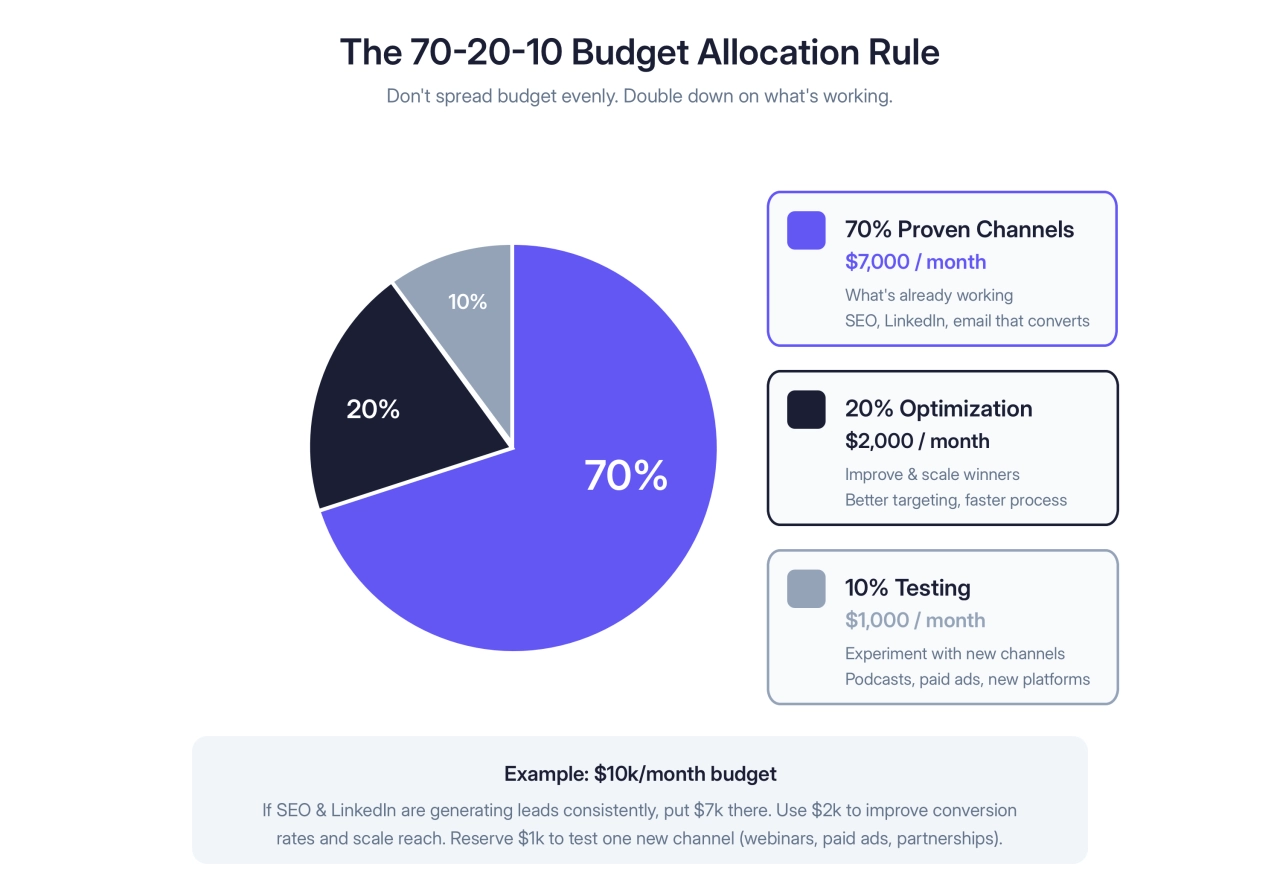
The 70-20-10 allocation framework:
70% of budget to proven channels generating consistent ROI
20% to optimizing and scaling those existing channels
10% to testing new approaches and channels
Budget level framework:
Monthly Budget | Strategy Focus | Tools | Team Approach |
|---|---|---|---|
Under $2,000 | Organic (personal brand, SEO, content) | Free/freemium versions | DIY, invest time over money |
$2,000-$5,000 | Organic + 1 paid channel | 2–3 core tools (Sales Navigator, CRM, email finder) | Consider outsourcing 1 function |
$5,000-$10,000 | Multiple paid channels | Full tool stack | Hire specialist or outsource specific functions |
Over $10,000 | Scale proven channels aggressively | Enterprise tools | Dedicated lead gen team members |
These ranges reflect average agency spending, but your actual costs depend on your market, deal size, and whether you’re building in-house or outsourcing. For detailed pricing breakdowns by channel and agency vs in-house costs, see our lead generation pricing guide.
Track ROI ruthlessly: Every dollar you spend should tie back to revenue generated. If you can’t measure it, either build the tracking or don’t spend the money. Refer back to the measurement section for formulas and tracking methods.
The agencies that scale their lead generation successfully aren’t the ones with the biggest budgets. They’re the ones who allocate resources strategically, measure everything, and adjust based on what the data tells them.
Frequently asked questions
What is the typical conversion rate from lead to client in B2B?
The average B2B lead-to-customer conversion rate sits around 2–5% across industries, according to Ruler Analytics research. If you’re working with more qualified leads (like webinar attendees or demo requests), expect 10–20%.
How do I choose the right CRM for my B2B lead generation efforts?
Start with a system that tracks conversations and enables consistent follow-up. HubSpot’s free CRM or Pipedrive both work well for agencies under $500k ARR. Upgrade to more robust platforms like Salesforce only when you’re managing complex enterprise sales processes that justify the cost and learning curve.
What are the best practices for lead nurturing email campaigns?
Segment your list, focus on value over pitching, and send weekly emails with one clear call-to-action. B2B sales take time, so don’t give up after two emails.
How can I personalize my B2B lead generation efforts for different buyer personas?
Create content for specific pain points, customize outreach to reference their situation, and segment lead magnets for different personas. Start with one persona and nail the messaging before trying to personalize for everyone at once.
What are the most effective lead magnets for B2B audiences?
Templates and frameworks people can use immediately (cold email templates, content calendars, pricing calculators) work incredibly well, along with industry reports containing original data. If your lead magnet doesn’t solve a real problem, don’t bother creating it.
How often should I analyze and optimize my B2B lead generation strategies?
Review tactics monthly (what’s working, what’s not) and make small adjustments, but only review strategy quarterly. Track metrics monthly but judge success quarterly. Different strategies have different timelines - see the strategy sections above for specific timeframes.
What role does AI play in modern B2B lead generation?
AI is useful for lead scoring, personalization at scale, chatbots for qualification, and spotting patterns in your data. For most small agencies, focusing on the basics (good targeting, helpful content, consistent follow-up) will move the needle more than any AI tool.
Start here: your first 30 days
Based on where you are right now, here’s your play:
If you’re under $100k ARR and maxed on billable hours: Focus on personal branding + email nurture. 3-5 hours/week. Free tools. 6-month commitment.
If you have $5k/month marketing budget: SEO + LinkedIn Sales Navigator. Hire contractor for content. 8-10 hours/week. 6-month commitment.
If you’re at $500k+ and hiring a BDR soon: Outbound prospecting + partnerships. Tools: Sales Navigator + Findymail. Train BDR on your ICP.
Block the time Monday. Protect it for 6 months. See you on the other side.
Can’t commit the time? Use outsourced lead generation and focus on delivery.

